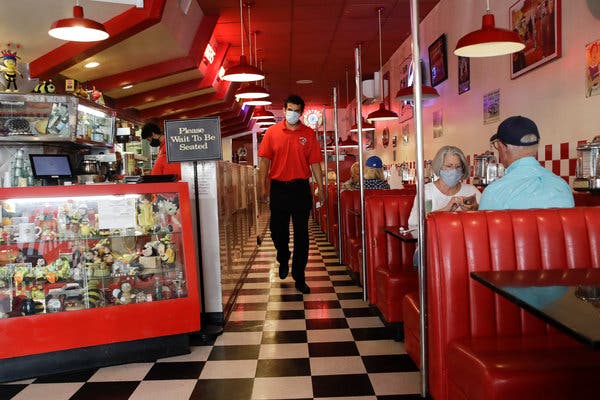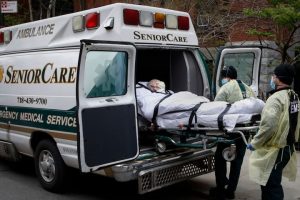Good morning.
(Don’t already get California Today delivered to your inbox? Here’s the sign-up.)
Earlier this week, when counties around the state were just beginning to get the green light from the state to reopen businesses like dine-in restaurants (with modifications) and stores that had previously been deemed nonessential, we asked readers living in those counties how they felt about it all.
Now, as more and more counties — including populous ones like San Diego and Sacramento — are added to the list, their emails felt to me as if they were coming from a less and less distant future.
So what can those of us living in counties that are still largely sheltered in place have to look forward to?
[Read more about California’s complex, phased reopening plan.]
Definitely not a return to normal — at least not yet.
Dana Kennedy, 49, wrote in an email that she visited a restaurant in Nevada City.
She said that there were plexiglass dividers between booths and that tables in an open area were spaced far apart.
The servers wore masks and, she said, everything was disinfected.
Ms. Kennedy said she felt safe, given that there hadn’t been many coronavirus cases in her town, but she still washed her hands before leaving the restaurant and used hand sanitizer again when she got in the car, and once more when she got home.
As for how it felt to be out, she wrote:
“I could equate it to the feeling of learning to swim; you so desperately want to learn. There is elation mixed with the fear of drowning. Then your feet and hands start to work their magic to keep you afloat, but you still want the safety of the edge of the pool. I think it’s important to test the waters so we can start swimming again, but do so with caution and common sense.”
The biggest change that Dr. Carlos Alvarez, a 58-year-old in Tuolumne County, noticed was that people seemed to have eased up on precautions.
Dr. Alvarez wrote that although the Walmart in Sonora has been open throughout the state’s lockdown — “bless their supply chain,” he said — it was much more crowded this week than previously.
“This is our version of any other place’s megachurch,” he said. “Folks come from miles to shop here.”
But this week, after his county eased restrictions, Dr. Alvarez said he was nervous, even while wearing a surgical mask and sanitizing his cart and hands.
Most other shoppers, he said, weren’t wearing masks or following floor markings guiding traffic through the store, though he said most did make efforts to keep their distance.
Terry Schneider, a 74-year-old in northern Humboldt County, wrote that she planned to “stay hunkered down until I feel things are more stable.”
Even though Humboldt is among those that have been allowed to reopen, and has relatively few cases, Ms. Schneider said that she had been at home on her own since the beginning of March, and that she hoped to see how case rates change after wider testing has been available for a couple more weeks.
She wrote:
“Do I really need new clothes, knickknacks, or household goods at this time? Nope! Anything I might want I can order online, although I have tried to be mindful of the environmental costs of shipping (and the health effects upon people who work in the warehouses and deliver the packages), so I haven’t done much of that either.”
Ms. Schneider added that she’s fortunate to live in a beautiful place, “so I have nature to keep me company.”
Mary Lou Giles, a 73-year-old in El Dorado County, wrote that she and her husband planned to shelter in place for at least another month.
She said she worried that county officials moved under pressure from people who oppose the stay-at-home orders for political reasons, although the county has seen no deaths from the virus yet.
Ms. Giles wrote:
“Would I like to patronize one of my favorite local restaurants or coffee shops? Would I like to browse through the fabrics at the quilt shop or the yarns at the yarn shop? Would I like to get back to my chiropractor and acupuncturist? Would I love to go wine tasting? Absolutely. Am I willing to be a guinea pig, testing just how much social distancing and sanitizing will keep the virus at bay? No.”
-
Frequently Asked Questions and Advice
Updated May 20, 2020
-
What are the symptoms of coronavirus?
Common symptoms include fever, a dry cough, fatigue and difficulty breathing or shortness of breath. Some of these symptoms overlap with those of the flu, making detection difficult, but runny noses and stuffy sinuses are less common. The C.D.C. has also added chills, muscle pain, sore throat, headache and a new loss of the sense of taste or smell as symptoms to look out for. Most people fall ill five to seven days after exposure, but symptoms may appear in as few as two days or as many as 14 days.
-
How many people have lost their jobs due to coronavirus in the U.S.?
Over 38 million people have filed for unemployment since March. One in five who were working in February reported losing a job or being furloughed in March or the beginning of April, data from a Federal Reserve survey released on May 14 showed, and that pain was highly concentrated among low earners. Fully 39 percent of former workers living in a household earning $40,000 or less lost work, compared with 13 percent in those making more than $100,000, a Fed official said.
-
How can I protect myself while flying?
If air travel is unavoidable, there are some steps you can take to protect yourself. Most important: Wash your hands often, and stop touching your face. If possible, choose a window seat. A study from Emory University found that during flu season, the safest place to sit on a plane is by a window, as people sitting in window seats had less contact with potentially sick people. Disinfect hard surfaces. When you get to your seat and your hands are clean, use disinfecting wipes to clean the hard surfaces at your seat like the head and arm rest, the seatbelt buckle, the remote, screen, seat back pocket and the tray table. If the seat is hard and nonporous or leather or pleather, you can wipe that down, too. (Using wipes on upholstered seats could lead to a wet seat and spreading of germs rather than killing them.)
-
Is ‘Covid toe’ a symptom of the disease?
There is an uptick in people reporting symptoms of chilblains, which are painful red or purple lesions that typically appear in the winter on fingers or toes. The lesions are emerging as yet another symptom of infection with the new coronavirus. Chilblains are caused by inflammation in small blood vessels in reaction to cold or damp conditions, but they are usually common in the coldest winter months. Federal health officials do not include toe lesions in the list of coronavirus symptoms, but some dermatologists are pushing for a change, saying so-called Covid toe should be sufficient grounds for testing.
-
Can I go to the park?
Yes, but make sure you keep six feet of distance between you and people who don’t live in your home. Even if you just hang out in a park, rather than go for a jog or a walk, getting some fresh air, and hopefully sunshine, is a good idea.
-
How do I take my temperature?
Taking one’s temperature to look for signs of fever is not as easy as it sounds, as “normal” temperature numbers can vary, but generally, keep an eye out for a temperature of 100.5 degrees Fahrenheit or higher. If you don’t have a thermometer (they can be pricey these days), there are other ways to figure out if you have a fever, or are at risk of Covid-19 complications.
-
Should I wear a mask?
The C.D.C. has recommended that all Americans wear cloth masks if they go out in public. This is a shift in federal guidance reflecting new concerns that the coronavirus is being spread by infected people who have no symptoms. Until now, the C.D.C., like the W.H.O., has advised that ordinary people don’t need to wear masks unless they are sick and coughing. Part of the reason was to preserve medical-grade masks for health care workers who desperately need them at a time when they are in continuously short supply. Masks don’t replace hand washing and social distancing.
-
What should I do if I feel sick?
If you’ve been exposed to the coronavirus or think you have, and have a fever or symptoms like a cough or difficulty breathing, call a doctor. They should give you advice on whether you should be tested, how to get tested, and how to seek medical treatment without potentially infecting or exposing others.
-
How do I get tested?
If you’re sick and you think you’ve been exposed to the new coronavirus, the C.D.C. recommends that you call your healthcare provider and explain your symptoms and fears. They will decide if you need to be tested. Keep in mind that there’s a chance — because of a lack of testing kits or because you’re asymptomatic, for instance — you won’t be able to get tested.
-
How can I help?
Charity Navigator, which evaluates charities using a numbers-based system, has a running list of nonprofits working in communities affected by the outbreak. You can give blood through the American Red Cross, and World Central Kitchen has stepped in to distribute meals in major cities.
-
[See how many coronavirus cases have been confirmed in each county.]
Here’s what else to know today
We often link to sites that limit access for nonsubscribers. We appreciate your reading Times coverage, but we also encourage you to support local news if you can.
-
The coronavirus has devastated nursing homes across the country. But it’s hitting nursing homes with predominantly black and Latino residents even harder. [The New York Times|LAist]
If you missed it, read more about why Covid-19 is deadlier for black and Latino Californians. [The New York Times]
-
And the governor’s proposed budget cuts two day programs aimed at keeping poor and medically fragile seniors out of nursing homes. [CalMatters]
-
The University of California voted to phase out the SAT and ACT as requirements to apply. The decision is likely to accelerate momentum of American colleges away from using the standardized tests. [The New York Times]
-
Mark Zuckerberg said Facebook would allow many employees to work from home permanently. The company is the first among tech’s giants to make such a decision, and it could profoundly reshape Silicon Valley as workers move to less expensive places. [The New York Times]
-
After she maintained her innocence for months, Lori Loughlin, along with her husband, Mossimo Giannulli, agreed to plead guilty to conspiring to get their daughters into the University of Southern California. She agreed to serve two months in prison. [The New York Times]
Take a look back at her first appearance in court in Los Angeles. [The New York Times]
-
Darrell Issa, the former Republican congressman who’s running for Congress again, is suing to block California’s move to mail every voter a ballot in November. [Politico]
-
Oakland Unified School District students could vote in school board elections if a measure on the city’s fall ballot is approved. [Berkeleyside]
Read more about past efforts to let 17-year-olds vote in California. [The New York Times]
-
Almost a century before President Trump referred to the coronavirus as the “Chinese virus,” a Methodist radio preacher called the plague sweeping through Los Angeles a “Mexican Disease.” [L.A. Taco]
-
Celebrities are (almost) just like us: Stuck at home. Which makes things difficult for the paparazzi. [The New York Times]
-
San Luis Obispo’s “Bubble Gum Alley” is open, for now — if checking out walls covered in chewed gum sounds good to you. [The San Luis Obispo Tribune]
And Finally …
It’s Memorial Day weekend. For many, it’s the traditional start of summer. Of course, this year, big celebrations and parades have been canceled.
But some of the salutes to veterans have moved online, and here in California, beaches have been reopened — with modifications — as have many parks.
We’ll be back on Tuesday. We wish you and your loved ones peace and health.
California Today goes live at 6:30 a.m. Pacific time weekdays. Tell us what you want to see: [email protected]. Were you forwarded this email? Sign up for California Today here and read every edition online here.
Jill Cowan grew up in Orange County, went to school at U.C. Berkeley and has reported all over the state, including the Bay Area, Bakersfield and Los Angeles — but she always wants to see more. Follow along here or on Twitter.
California Today is edited by Julie Bloom, who grew up in Los Angeles and graduated from U.C. Berkeley.



















